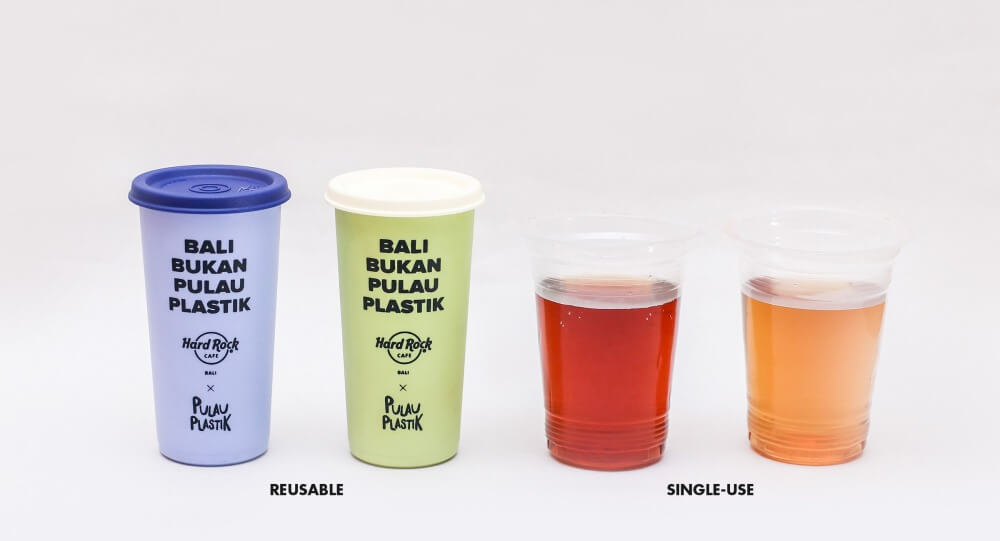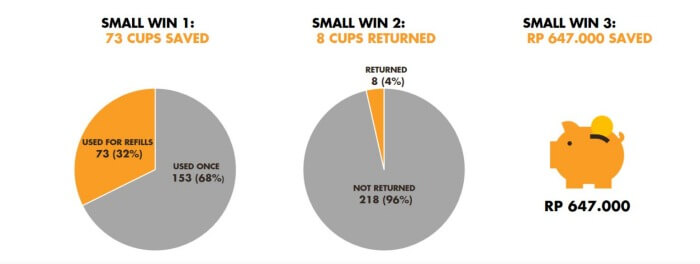
In early September 2019, we conducted an experiment at Soundrenaline – Bali’s largest annual music festival. We partnered with Hard Rock Cafe to test the use of reusable cups to serve drinks instead of the typically used single-use plastic cups.

We embarked on this experiment as part of our initiative to reduce the use of single-use plastics and the subsequent negative environmental impact they have such as leakage into the marine environment.
Our objectives were threefold:
1. Reduce the number of single-use plastic cups used by using reusable cups,
2. for people to use the reusable cups more than once, and;
3. for the cups to be returned so that they can be re-used at another event.
The Hard Rock Cafe drinks booth at the event served all of their (non-canned) drinks in the reusable cups. This was the first time the Hard Rock Cafe had attempted this type of initiative. The customer paid a Rp. 20,000 deposit (equivalent of USD1.42) for the cup with the first drink and could re-use the cup when purchasing a subsequent drink. The first drink was Rp80,000, and Rp60,000 (Rp80,000 - cup cost of Rp20,000) for each drink thereafter. The customer could return the cup at any time and receive their Rp20,000 deposit back.
So how did it go?
Small win 1: 226 reusable cups were used during the event, with an additional 73 refills resulting in a saving of 73 new cups being used.
Small win 2: Only 4% of cups were returned with just eight people collecting their deposit upon return, resulting in a saving of 8 cups to be produced for future events. There were no observably discarded cups, suggesting that people took the cups home with them.
Small win 3: Because the cost of the reusable cup was fully covered by the deposit, a minor cost saving of Rp647,000 (USD 46) - 8% of the revenue for the day - was made by the organizer, where previously the cost of the single-use plastics was borne by The Hard Rock Cafe.

The majority of the environmental impact, usually around 80% from any type of cup, occurs because of manufacturing. This includes raw materials, water, energy and long-distance transportation. Other impacts include local transport, washing and what happens to the cup after it has been used.1
Although each event and scenario is different, some studies indicate that a reusable cup is the better environmental option compared to a disposable PET cup after 2.5 uses.2
Therefore, in order for a reusable cup to realize the environmental benefits, it’s important to develop a system where the majority of cups are returned into the system and reused at future events. Because we don’t know what happens to the cups if they are not returned we are unable to assume that they will be reused.
We see this experiment as a small, but overall positive step towards reducing the use of single-use plastic cups – however the big question remains – how do we get more people to return reusable cups so that the environmental benefits are realized?
We have a few reasons in mind that so few cups were returned: Was it because the deposit was too low? Was it too inconvenient for people to return the cup? Was the cup too attractive? It seems that attractive, branded cups are more likely to be kept as souvenirs by visitors to an event such as this one. This may mean that more plastic is produced and thus increase the environmental impact. A carefully designed reuse and deposit system is therefore necessary.
What do you think? Do you have any examples that we can learn from to increase the return rate?
2. Screening LCA: Comparison of single-use and reusable cups (Open Air St. Gallen 2010), Quantis. a study from a Swiss festival, OpenAir St. Gallen


